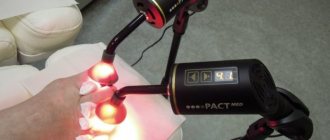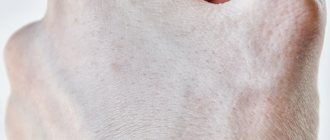Hyperpigmentation of the skin, which is explained by the excessive formation of melanin, is accompanied by the appearance of formations and color changes. Since modern technologies solve many aesthetic problems in the field of cosmetology, laser removal of age spots is currently widespread.
Based on the depth of melanin in the skin, these spots are divided into:
- epidermal (superficial);
- dermal (located deep in the skin);
- epidermal-dermal (mixed) spots.
Benefits of the procedure
Laser pigmentation removal involves local exposure to problem areas in order to destroy excess melanin structures. Since the depth and intensity of beam penetration can be adjusted, healthy tissue is not affected and side effects are eliminated. remove pigment spots with a laser in 1-3 sessions - your doctor will tell you more after the examination. The list of contraindications is minimal, there are no age restrictions, so the procedure is in high demand. The average time of exposure to one area of the face or body is 5-15 minutes. Laser pigmentation can be removed quickly, painlessly, with a minimal rehabilitation period - which is why the procedure is in high demand. The effectiveness is high, but if the appearance of spots was caused by problems in the functioning of internal organs (usually the liver), an integrated approach, namely local laser removal of pigmentation on the face and treatment of systemic diseases).
Similar problems and solutions:
Treatment of age spots on the face Treatment of age spots on the body Peeling against age spots
Indications
The indication for laser removal is the presence of the following formations on the face and other parts of the body:
- vascular angiomas (neoplasms) and red spots;
- chloasma - excessive pigmentation due to changes in hormonal levels or diseases of the genitourinary system;
- freckles - small pigment spots on the skin, from light yellow to light brown;
- senile lentigines or senile spots - hyperpigmentation of the skin due to the accumulation of melanin;
- pigmented scars (except keloids);
- spots that appear after sunburn;
- epidermal nevi - moles and birthmarks;
- pigmentation that appears at the site of a healed injury;
- traces of acne and acne;
- seborrheic keratosis - multiple superficial papillomatous formations.
It is worth noting that currently there are various methods for correcting skin defects: chemical peels, mesotherapy, cryopilling, etc. However, they act superficially, only partially removing pigment and promoting cell regeneration. The clinic specialist will definitely give an opinion on the need for a procedure to remove pigment spots with a laser if the above methods seem insufficient.
This cosmetic procedure is an intervention in the skin. Despite the fact that the complexity of the procedure and the period of further recovery do not require a hospital stay, it is classified as a surgical intervention. In this regard, there are a number of contraindications.
Equipment
Laser removal of age spots on the face at GMTCLINIC is carried out using professional equipment - laser or photo technology. The procedure is painless, cells containing the melanin pigment absorb the rays, after which the epidermis in the treatment area begins to collapse and peel off, being replaced by healthy structures. In our work we use:
- alexandrite device Candela, neodymium Quanta System Duetto;
- photo technologies Elos, M22 and Sciton;
- laser resurfacing for problem skin using MultiPulse CO2, Dermablate MCL-31, Fraxel and Sciton.
Elos targets cells with a high content of melanin; the depth of penetration of the beam in this case will be higher. which laser is best for removing pigmentation during a face-to-face consultation. Each device has its own features and advantages that are taken into account when choosing.
Phototherapy process in the salon
All stages of the light treatment procedure are its inseparable components. There is a high probability that the absence of one of them will lead to irreparable consequences. Let's look at the points:
- The doctor conducts a consultation, where during the examination he determines the color type of appearance, sensitivity to light, examines the lesion and sets the duration of treatment;
- Be sure to clarify the presence of certain health problems, if any, since the use of this method may be unacceptable (read below for contraindications);
- It treats the skin, thereby eliminating all possible contaminants; – applies a cooling and analgesic gel. Safety glasses must also be provided to protect against eye burns;
- The device acts on the skin, which can cause the patient a pleasant warmth and slight tingling sensation;
- The procedure approximately takes about half an hour. In conclusion, the cosmetologist applies a composition that soothes the skin and determines the time of the next visit and, if necessary, gives advice on home care.
As a rule, after the session, the doctor prohibits sunbathing and recommends constantly protecting the skin from the sun. You should also not visit the bathhouse or sauna for several days. During phototherapy, the skin becomes stressed, melanin is destroyed, and the skin is renewed. Therefore, elevated temperatures in the first days after the procedure can contribute to the formation of new age spots. Sometimes reactions such as peeling, redness, burning, and in some cases swelling may occur after the procedure, but all these abnormalities quickly pass.
Preparation for the procedure, rehabilitation, contraindications
The laser for pigmentation helps very well, but in order for the procedure to give maximum results without side effects, you need to properly prepare for it. 2-4 weeks before the procedure, avoid visiting beaches, baths, solariums, and swimming pools; maintain the same pause after laser exposure. There are restrictions on taking ibuprofen, aspirin and derivatives - they are removed a month before laser treatment, retinoids and drugs based on them are removed 3 months before. Contraindications are standard for all cosmetic interventions - oncology, severe pathologies of blood vessels, heart, blood, internal organs, diabetes. In case of exacerbation of chronic diseases, the procedure is not performed; it is also not recommended during lactation or pregnancy. We draw your attention to the fact that these contraindications are relative - if you have any doubts, contact a clinic specialist, and he will tell you for sure whether the procedure can be done specifically in your case. Do not treat skin with laser if there are wounds or rashes in the treatment area.
Contraindications
Phototherapy should be abandoned to avoid negative health consequences if the patient:
- increased photosensitivity;
- presence of herpes;
- malignant tumors and various skin diseases; d) tanning and self-tanning received within 14 days before the procedure;
- pregnancy;
- diabetes;
- poor blood clotting;
- severe cardiovascular pathology (high blood pressure);
- the presence of scars that penetrate into the surrounding healthy tissue (keloid);
TOP 50 ADVANTAGES OF THE GMTCLINIC NETWORK
Result guarantee
Modern equipment
The best specialists
Many awards
SIGN UP AND RECEIVE A 7% DISCOUNT ON YOUR FIRST PROCEDURE, CONSULTATION AS A GIFT!
Make an appointment Request a call Special offers
All procedures for solving aesthetic problems and prices
Choose a time, make an appointment +7 499 2900029 and come!
If you need laser pigmentation removal, go to GMTClinic!
Why does skin become pigmented?
There are many reasons for this. For example:
- heredity;
- hormonal background;
- taking various medications;
- UV rays;
- chronic diseases;
- lack of vitamins;
- infections.
There are several causes of skin pigmentation
However, the main reason on that list is a combination of three factors:
- increased skin sensitivity to UV rays;
- local damage to the epidermis;
- exposure to UV rays.
Often caused by exposure to UV rays
The first is provoked by the use of certain medications and cosmetics. The second happens as a result of burns, various procedures in a beauty salon, inflammation, even just cuts. For the third, it is enough to go to the solarium or expose your face to the sun.
Note! Alas, many women brush aside the advice of cosmetologists who warn them against sunbathing after cosmetic procedures. This is very stupid on their part: the doctor gives recommendations not at all in order to annoy the patient with restrictions, but so that he can avoid unpleasant complications and/or increase the effect of the procedure, and not reduce the result to zero. And if the patient also uses drugs that can increase the skin’s photosensitivity, everything can be even worse.
Sunbathing is not recommended after cosmetic procedures.
Here are the main groups of such funds:
- antibiotics - sulfonamides, tetracycline, doxycycline;
- antifungals - voriconazole, itraconazole;
- non-steroidal drugs for inflammation - celecoxib, naproxen, nurofen;
- diuretics - furosemide;
- retinoids - vitamin A and products containing it;
- psychotropic medications;
- some medications that lower glucose levels.
The same is true for using cosmetics containing salicylates and parabens.
There are serious risk factors:
- ovarian dysfunction and other hormonal problems, such as adrenal insufficiency;
- hormone replacement treatment for menopause;
- metabolic disorders and/or lack of certain vitamins, for example C or PP;
- infections such as syphilis, malaria, tuberculosis;
- pathologies of the gastrointestinal tract and other digestive organs, in which vitamins and microelements are less absorbed;
- liver pathologies;
- systemic connective tissue diseases;
- some dermatoses.
Gastrointestinal pathologies are one of the risk factors for pigmentation
Also, a factor such as unsuitable genetics plays a very important role here. It often affects appearance. Here are the traits that indicate a tendency toward hyperpigmentation:
- blond/red hair color;
- Thin hair;
- Blue eyes.
Note! The last two features indicate the 1st or 2nd skin phototype, which also clearly does not reduce pigmentation.
Devices – Removal of pigmentation
Optima IPL
Lumenis
IPL device for the treatment of dry eye disease
M22
Lumenis
Multi-module IPL platform, fractional laser, Nd:YAG, Nd:YAG QS
GeneO+
Pollogen by Lumenis
Platform for oxygenation, RF lifting, ultrasonophoresis and massage
Fraxel
Solta Medical
Non-ablative fractional laser with intelligent optical system
Cryo 6
Zimmer Medizin System
Cryotherapy device Cryo 6 for cosmetology and dermatology
AcuPulse
Lumenis
Superpulse fractional CO2 laser for cosmetology and gynecology
All Devices
What happens after laser depigmentation?
If laser depigmentation is performed incorrectly and/or despite the patient having contraindications, this will necessarily entail great danger in the form of complications, sometimes very severe ones. The skin can be permanently and irreparably damaged by even too strong laser exposure, which an inexperienced doctor can choose. Occasionally, laser pigmentation causes the following complications:
- scarring;
- suppuration;
- severe inflammation;
- secondary infection;
- necrosis;
- damage to previously healthy skin;
- unhealthy skin lightening;
- erythema.
If the procedure is performed incorrectly, complications may occur.
How does facial biorevitalization work and who is it suitable for?
Preparations for biorevitalization are made on the basis of hyaluronic acid. This acid is natural for the skin, and it itself is capable of being produced in the dermis, but with age this ability weakens, and in order to maintain skin tone, outside help is already needed. As a rule, before the age of 25 there is no need to resort to biorevitalization with hyaluronic acid, but even after 35 the effect will not be enough, so it’s time to think about going to a cosmetologist - age 30+.
Hyaluronic acid, entering the inner layers of the skin using injections or lasers, is able to attract and retain water molecules necessary to moisturize the skin, and hyaluronic acid provokes the production of collagen and elastin proteins, which are responsible for skin tone, fill fine wrinkles and create small lifting effect.
Biorevitalization with hyaluronic acid can be done not only on the face, but also on open areas that show age-related changes: neck, décolleté and even hands, as well as on particularly sensitive areas such as eyelids and the area around the ears.
Of course, there are lines of skin care cosmetics, including creams and masks, containing hyaluronic acid, but the molecules of this acid are too large to penetrate into the required depth layers of the skin, and therefore do not provide any special results other than superficial hydration.
Problems that biorevitalization with hyaluronic acid solves:
- Tired skin syndrome, puffiness and bruising under the eyes
- Dull complexion, dryness and flaking
- Fine wrinkles
- Acne marks, pigmentation, scars
- Couperosis, wide pores and acne
After the procedure, the skin is more hydrated, radiant, the oval of the face is tightened, and signs of fatigue disappear.
Expert reviews - Pigmentation removal
GeneO+
The geneO+ hardware platform quickly won the trust of all specialists in our clinic, since from the very first procedures we received a result that every patient can clearly see. More details
GeneO+
Kerbs Valentina Pavlovna
Geneo+ is an Israeli cosmetology device that is in demand all over the world. My clients and I were very impressed after using it. In a short time, Geneo+ allows you to get radiant, smooth, nourished and healthy skin without pain and rehabilitation, which is very important these days. More details All Expert reviews
Benefits of pigmentation treatment at Renew
For the clients of our clinic, we are always ready to choose the best and most profitable method of solving the problem. A device with an active IPL module allows you to generate targeted radiation depending on the characteristics of the skin and the extent of the lesion. The device also features the latest generation of cooling technology, which allows for virtually painless procedures. Among other advantages of treatment using the M22 device, I would like to note:
- Quick results. Already after the first session, the visible effect is manifested in the disappearance of small dilated vessels and small pigmented areas. The quality of the skin improves, collagen production is activated.
- Long lasting effect. From the moment the first session is completed, the processes of recovery and regeneration only intensify and reach their peak after 4-6 months.
- Comfort. To perform procedures with this device, no anesthetic is required.
- No consequences of the procedure. The Lumenis M22 device leaves virtually no traces after use, i.e. There are no burns or other injuries. Achieved through individual adjustment of radiation parameters.
Thus, getting rid of pigmentation pathologies occurs in just a few minutes (in complex cases, several sessions may be needed), completely painlessly and without a rehabilitation period.
The main types of pigment spots that laser removes
The Photon laser removes facial pigmentation of any degree of occurrence and severity. The result depends on the number of sessions and combination with other procedures. To remove light surface stains, 1-2 visits to the clinic are enough. To get rid of deep ones, it will take 4-6 sessions. We guarantee 100% effectiveness of the procedure if you follow the doctor’s recommendations!
MIGUNOVA ANASTASIA ANDREEVNA
Cosmetologist
Initial consultation: RUB 3,500
To make an appointment with a doctor
MALISHAUSKAS IRMA YUREVNA
Cosmetologist
Initial consultation: RUB 3,500
To make an appointment with a doctor
VYATKINA IRINA SERGEEVNA
Gynecologist-endocrinologist
Initial consultation: RUB 7,500
To make an appointment with a doctor
KALININA EKATERINA ALEXANDROVNA
Cosmetologist
Initial consultation: RUB 3,500
To make an appointment with a doctor
KOZLOVA EKATERINA NIKOLAEVNA
Gynecologist, oncologist
Initial consultation: RUB 4,000
To make an appointment with a doctor
Events – Removal of pigmentation
June 18, 2020 - June 18, 2020 | Moscow M22 | AcuPulse | LightSheer DUET | GeneO+ | LightSheer DESIRE
Training course “High-energy techniques in cosmetology”
The course is intended for cosmetologists who use or plan to use laser and light techniques in their practice. The main topic of the course is the treatment of alopecia using non-ablative fractional lasers.
April 13, 2020 | Moscow M22 | AcuPulse | LightSheer DUET | GeneO+ | LightSheer DESIRE
Training course “High-energy techniques in cosmetology”
The course is aimed at training doctors who wish to expand and improve their theoretical knowledge and practical skills in the use of IPL systems, vascular lasers, ablative and non-ablative fractional lasers
All Events
Advantages and disadvantages
Stains with pigment can be removed in many ways, but to choose the method that is suitable for a particular case, it is worth weighing the pros and cons of the procedure. Speaking about whitening injections, you should pay attention to the following advantages:
- non-toxicity of cocktail components;
- improvement of vascular condition;
- whitening;
- skin tightening;
- no effect on sleep;
- stabilization of blood circulation;
- lasting results;
- suitable for all parts of the body;
- minimum contraindications;
- speed of manipulation.
But mesotherapy has a number of disadvantages, although they do not offset the positive aspects. Since complications occur due to the fault of the cosmetologist who performed the manipulation. Due to the incorrect algorithm of the procedure, bruises appear and swelling is possible. With insufficient examination, allergic reactions, anaphylactic shock or Quincke's edema begin. If the syringe with the drug is administered incorrectly, there is a risk of vasodilation and necrosis of skin tissue. But the high cost is considered a clear disadvantage of mesotherapy.
Which laser is the best?
It is best to use a fractional laser against age spots. It gives excellent results and never harms the skin. Microdamage from a fragmented bundle is no larger in diameter than a hair on the head of any of us. In this case, only diseased cells are destroyed, and all melanin evaporates from them. But healthy people are not affected in any way.
Fractional laser is considered more effective in getting rid of age spots
Rehabilitation period
During laser depigmentation by a specialist, no special rehabilitation period is necessary. The patient can live as usual immediately after the laser therapy procedure.
Note! This effect causes the skin to turn red for an hour. Then it peels off for about a week.
Complications may occur after the session
Here are the actions that should be avoided for a day after the procedure:
- water entering the area exposed to the laser;
- application of decorative makeup.
Here's what you need to avoid for about 15 days:
- expose your face to UV rays;
- deep peeling;
- use of alcohol-based external cosmetics.
You should not resort to peeling procedures for about two weeks.
And here is what is required in these two weeks:
- be careful to prevent damage to the laser-treated area;
- use of sunscreen, and the protection factor should be more than 30.
Reasons for the formation of age spots
The appearance of darkened areas can be influenced by external and internal reasons. External reasons:
- prolonged exposure to the open sun or solarium;
- use of hormonal cosmetics or low-quality cosmetics;
- taking certain hormonal and antibacterial drugs.
Internal causes of pigmentation:
- hormonal imbalance of the body during pregnancy, menopause and old age;
- deficiency of vitamins and minerals in the body, for example, folic acid;
- disorders of the thyroid gland and liver;
- genetic predisposition to the formation of age spots;
- prolonged contact with rubber products and synthetics;
- procedures that violate the integrity of the epidermis;
- psychotrauma, depression and other neurogenic causes.
What are age spots?
Melanin is responsible for the formation of pigmentation in the body. It is involved in coloring the hair and iris of the eyes, and is also formed in the upper layer of the skin (in the epidermis), for example, when it is exposed to ultraviolet radiation. The more melanin, the darker the color of a certain area becomes. Due to various reasons, an increased amount of melanin is formed in some areas of the body and face. As a result, a pigment spot appears, which can be light or dark, have regular or irregular outlines.
There are several types of such formations, but they are always considered a cosmetic defect that needs to be treated. In this area, the area of skin often becomes rough, dry and prone to wrinkles.
Important! Before getting rid of age spots using home remedies or salon procedures, you should make sure that they are not moles or cancerous tumors. To do this, you need to consult a dermatologist. He will advise you on how to quickly remove age spots from your face and determine what type they belong to.
To find the most suitable way to solve the problem, you need to find out the cause of increased skin pigmentation. There are several types of age spots that you can get rid of forever using hardware or home cosmetology.
- Freckles are common in people with fair skin. When exposed to ultraviolet light, they become more noticeable, and in the cold season they are almost invisible.
- Nevi (birthmarks) are accumulations of pigment in the layers of the skin. Most often they have smooth, round outlines.
- Melasma (chloasma) is a type of age spots that appear as large areas of pigmentation with irregular outlines. Most often they are a consequence of hormonal disorders and occur in young girls. Melasma can increase in size upon contact with ultraviolet light and merge with each other, covering the entire face and neck.
- Lentigo is a common condition for older people who have had excessive skin exposure to sunlight throughout their lives. It often appears on the hands and face, making a person look older than his age. Fans of artificial and natural tanning and people working outdoors fall into the risk category for lentigo.
- Vitiligo (albinism) is considered the rarest type of age spots. It is harmful for people with vitiligo to be in the open sun. There are practically no melanocytes in their body, and therefore discolored patchy areas can be seen on the skin. Direct sunlight can cause them to burn or become malignant. The reasons for the appearance of such pigmentation are poorly understood, and therefore vitiligo is practically untreatable.











